Depending on where you live, Chiba either has several train lines or very few. If you have never ridden a train, especially not in Japan, it can be a challenge. However, mastering the train system will make your life much more convenient.
Table of Contents
- About Trains in Chiba
- Regional Information
- How to Look up Train Times
- How to Look up Train Times using Hyperdia.com
- How to Check for Train Delays
About Trains in Chiba
Train lines in Japan are managed by companies, which you can identify by the name of the line. The biggest train company is Japan Railways (JR); but in Chiba and Tokyo, you will see other train lines, such as Tokyo Metro, Keisei, etc. Within each company group, there are often several lines that you can easily transfer to without having to pay separately for each line. Each company sets its own rates and times, and some lines are more expensive than others. Bear in mind that trains stop running at night (anywhere between 10 pm and 1 am, depending on the train line), so make sure you always check when your last train home is (終電 shūden or 最終 saishū) before going out!
Return to Top
Riding the Train
The three names or pieces of information to remember when using a train:
- Your destination station: 駅 (eki)
- The line(s) you will need to use to get there: 線 (sen)
- The last station the train is bound for: 行き (yuki)
NOTE: This will be listed on signs in the station so you know which platform to use for the direction you are going.
For the most part, all stations in Chiba are clearly marked in English and Japanese, with signs that will guide you through a station when transferring lines. Many train lines in Chiba, especially near Tokyo, announce or display the next stop, final station, and transfer lines in both English and Japanese.
Return to Top
IC Cards
If you ride the train frequently or plan to visit Tokyo, it is very convenient to get an IC card, such as Suica or PASMO. You can charge your card with cash at the train station, then touch your card at the ticket gate. This saves you from having to buy a ticket every time you change lines. IC cards can be bought at machines (with a deposit) at most major stations. Ask a station attendant if you require assistance. Keep in mind that some local private lines may not accept IC cards.
Return to Top
Etiquette
Once on board the train, the general etiquette is to keep your voice low and your belongings stored at your feet or on the rack above your head. You should give up priority seats for passengers that need it. Sitting on the floor or lying across multiple seats is not allowed. Eating and drinking is allowed, but be sure to properly dispose of your trash.
Return to Top
Map of Trains in Chiba Prefecture
Return to Top
The below links are connected to the corresponding Wikipedia page.
JR East Japan
- Sōbu Main Line(総武本線 Sōbu honsen
- Chūō-Sōbu Line (中央総武緩行線 Chūō Sōbu kankō-sen): Runs from Chiba Station to Mitaka Station (Tokyo). Major stops include Akihabara, Yoyogi, and Shinjuku.
- Sōbu Line (Rapid) (総武快速線 Sōbu kaisoku sen): Runs from Chiba Station to Tokyo Station (Tokyo). Some trains connect to the Yokosuka Line, which travels through major stops such as Yokohama and Kamakura. Within Chiba, the Sōbu Line (Rapid) may also travel as far as Kazusa-Ichinomiya (Sotobō Line), Kimitsu (Uchibō Line), Narita Airport (Narita Line), Kashima-Jingū (Kashima Line), and Narutō (Sōbu Main Line).
- Jōban Line (常磐線 Jōban sen): Runs from Nippori Station (Tokyo) to Kita-Senju (Tokyo), Matsudo, Toride (Ibaraki), Tsuchiura (Ibaraki), or Mito (Ibaraki) stations.
- Narita Line (成田線 Narita sen): Runs from Chiba Station to Chōshi Station (main line), Narita Station to Abiko Station (Abiko branch line), or Narita Station to Narita International Airport (Airport branch line).
- Uchibō Line (内房線 Uchibō sen): Runs along the western (inner) shore of Chiba from Chiba Station to Awa-Kamogawa Station.
- Sotobō Line (外房線 Sotobō sen): Runs along the southeastern (outer) shore of Chiba from Chiba Station to Awa-Kamogawa Station.
- Keiyō Line (京葉線 Keiyō sen): Runs from Tokyo Station (Tokyo) to Soga Station along the coast of Tokyo Bay. Major stops include Maihama (Tokyo Disney Resort), Minami-Funabashi, and Kaihin-Makuhari.
- Musashino Line (武蔵野線 Musashino sen): Runs from Fuchū-Hommachi Station (Tokyo) to Nishi-Funabashi Station.
- Tōgane Line (東金線 Tōgane sen): Runs from Ōami Station to Narutō Station.
- Kashima Line (鹿島線 Kashima sen): Runs from Katori Station to Kashima Soccer Stadium Station (in Ibaraki Prefecture).
- Kururi Line (久留里線 Kururi sen): Runs from Kisarazu Station to Kazusa-Kameyama Station.
Return to Top
Keisei
- Main Line (京成本線 Keisei honsen): Runs from Keisei-Ueno Station (Tokyo) to Narita International Airport.
- Narita Sky Access (成田スカイアクセス Narita sukai akusesu): A rapid train running from Keisei-Ueno Station (Tokyo) to Narita International Airport.
- Chiba Line (京成千葉線, Keisei Chiba sen): Runs from Keisei-Tsudanuma Station to Chiba-Chūō Station.
- Chihara Line (京成千原線, Keisei Chihara sen): Runs from Chiba-Chūō Station to Chiharadai Station.
- Higashi Narita Line (京成東成田線 Keisei Higashi Narita sen): Runs from Keisei-Narita Station to Higashi-Narita Station.
- Shin-Keisei Line(新京成線 Shin Keisei sen
- Hokuso Line (北総線 Hokusō sen): Runs from Keisei-Takasago Station (Tokyo) to Imba-Nihon-Idai Station.
Return to Top
Other Companies
- Toyo Rapid Line (東葉高速線 Tōyō kōsoku sen): Runs from Nishi-Funabashi Station to Tōyō-Katsutadai Station.
- Shibayama Railway (芝山鉄道 Shibayama Tetsudō): Runs from Higashi-Narita Station to Shibayama-Chiyoda Station.
- Tobu Urban Park Line (東武アーバンパークライン Tōbu Ābanpāku rain): Runs from Ōmiya Station (Saitama) to Funabashi Station.
- Tsukuba Express (つくばエクスプレス線 Tsukuba Ekusupuresu sen): Runs from Akihabara Station (Tokyo) to Tsukuba Station (Ibaraki).
- Tokyo Metro Tozai Line (東西線 Tōzai sen): Runs from Nakano Station (Tokyo) to Nishi-Funabashi Station.
- Toei Shinjuku Line (都営地下鉄新宿線 Toei chikatetsu Shinjuku sen): Runs from Shinjuku Station (Tokyo) to Moto-Yawata Station.
- Nagareyama Line (流山線 Nagareyama sen): Runs from Mabashi Station to Nagareyama Station.
- Choshi Electric Railway (銚子電気鉄道 Chōshi denki tetsudō): Runs from Chōshi Station to Tokawa Station.
- Kominato Railway (小湊鉄道 Kominato tetsudō): Runs from Goi Station to Kazusa-Nakano Station.
- Isumi Railway (いすみ鉄道 Isumi tetsudō): Runs from Ōhara Station to Kazusa-Nakano Station.
Return to Top
People Movers
-
- Chiba Urban Monorail (千葉都市モノレール Chiba Toshi Monorēru): Line 1 runs from Chiba-Minato Station to Kenchō-mae Station. Line 2 runs from Chiba-Minato Station to Chishirodai Station. Both lines stop at Chiba Station.
- Yamaman Yūkarigaoka Line (山万ユーカリが丘線 Yamaman Yūkarigaoka sen): A local people mover in the Yūkarigaoka district in Sakura City.
Return to Top
By Region
Block 5
Sobu Main Line

Choshi Electric Railway

Return to Top
Block 6
Togane Line
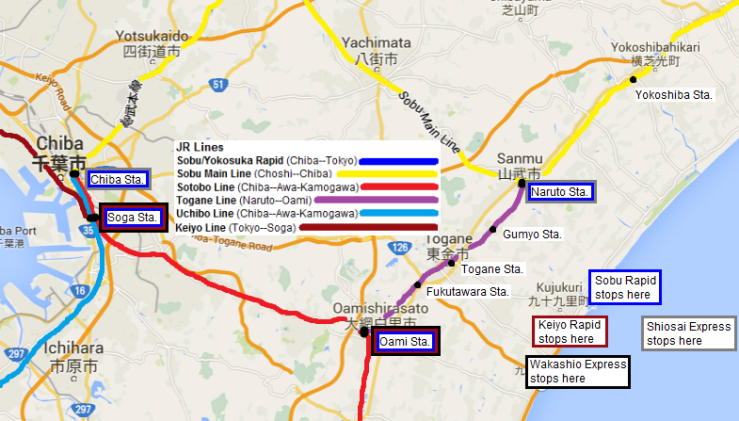
Return to Top
Block 7
Sotobo Line
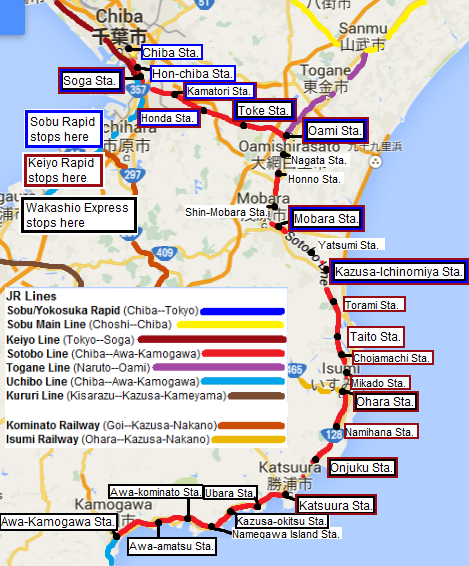
Return to Top
Block 8
Uchibo Line
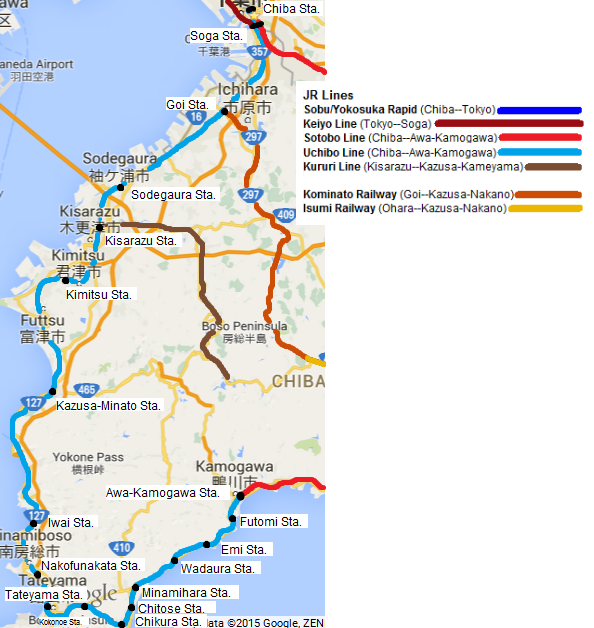
Return to Top
How to Look up Train Times
There are several useful websites for looking up train times:
- Hyperdia (English/Japanese)
- Jorudan (English/Japanese)
- Yahoo! Japan (Japanese only)
- Navitime (Japanese only)
Hyperdia and Yahoo! Japan provide Smartphone apps. In Japanese, the apps are called 乗換案内 (norikae annai).
Return to Top
How to Look up Train Times Using Hyperdia.com
Let’s use the English version of Hyperdia.com to go from Togane to Soga.
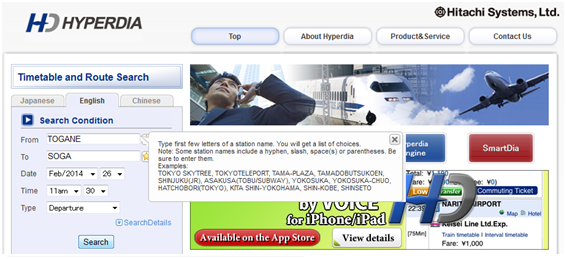
Type in your starting and ending points. It will automatically choose the current time, but you can also set it to what time you want to arrive by. Be careful with hyphenated station names and long o’s.

Great, there’s a Togane Line train that goes straight there! Take note of the time it will take, the cost, and of course the time the train leaves. Don’t trust the computer too much…
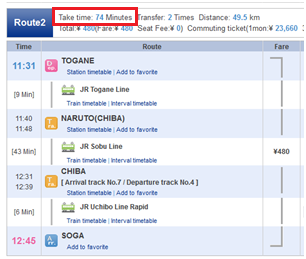
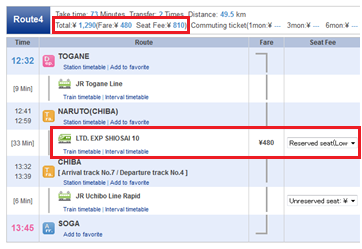
Route 2 sends you on a route that takes twice as long, and Route 4 sends you on an express that costs a lot more. Sometimes Hyperdia and other train checkers get creative, so don’t trust them too blindly. Plan your trip in advance so you can take the best way there.
Return to Top
How to Check for Train Delays
Main Page: How to Check for Train Delays
Train lines may be delayed due to weather, safety checks, passenger injury, or a number of other reasons. Delays will be announced on TV, on train apps, and on certain websites.
- For all Kanto area lines: JR East English page
- For Tokyo train lines: Is it delayed.com
If you use a Japanese train app like Jorudan, Navitime or Yahoo! Japan’s 路線情報 (rosenjōhō), delays will be announced next to a warning (!) icon. Some helpful Japanese words are listed below:
| 運行情報 | unkō jōhō | service information |
| 運行状況 | unkō jōkyō | service status |
| (列車)遅延 | (ressha) chien | (train) delay |
| 運転見合わせ | unten miawase | service stopped and will resume as soon as possible |
| 運休 | unkyū | service is stopped or cancelled indefinitely |
| 運転再開 | unten saikai | service resumed |
| 平常運転 | heijō unten | trains are running normally |
| 人身事故 | jinshin jiko | passenger injury |
| 台風の影響で | taifū no eikyō de | due to the typhoon |
Check here for more useful disaster-related vocabulary in Japanese.

